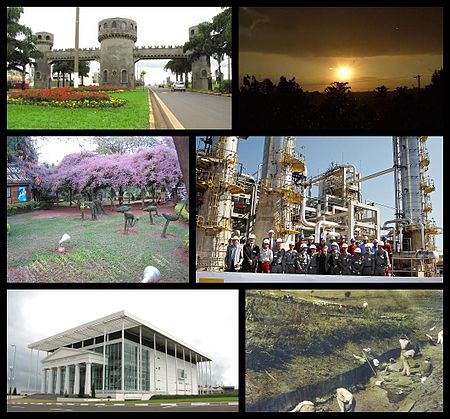Paulínia

Paulínia is a Brazilian municipality in the interior of the state of São Paulo. It is located in the northwest of the São Paulo Macrometropolis and is about 119 km from the state capital. It occupies an area of 139 km² and in 2018, IBGE estimated its population at 106,776. It was emancipated on February 28, 1964, but its foundation dates back to the beginning of the 20th century. The town is named after José Paulino Nogueira, a well-known farmer in the Campinas region, the municipality from which Paulínia emancipated and who lent his name to the railroad station around which the town developed. It is located in the Rio-São Paulo axis, serving as a link between Greater São Paulo and cities in the area, such as Cosmópolis, Artur Nogueira, and Conchal. It is known for hosting one of the largest petrochemical poles in Latin America, centered on the Paulínia Refinery (Replan). Thanks to Replan and the petrochemical pole, which are based in the northern part of the city, Paulínia has the seventh highest per capita income in Brazil. Also due to the pole, the city presents high levels of ozone pollution, mainly in the district of Betel and in the Replan region, where companies such as Rhodia, Purina, Shell, Syngenta, and Petrobras are located. Paulínia stands out for its intense population growth, the largest in the Metropolitan Region of Campinas. Historically, the service sector has not been very important for the municipality, but recently it has been developing because of projects like Paulínia Magia do Cinema (English: Paulínia Magic of Cinema). The municipality is formed by the city of Paulínia and the district of Betel, in the eastern region. Paulínia is part of the so-called Extended Metropolitan Complex, which exceeds 29 million inhabitants, approximately 75% of the population of the entire state of São Paulo. The metropolitan regions of Campinas and São Paulo already form the first megalopolis in the southern hemisphere, uniting 65 municipalities that together are home to 12% of the Brazilian population.
Excerpt from the Wikipedia article Paulínia (License: CC BY-SA 3.0, Authors, Images).Paulínia
Rua Malavazzi, Paulínia
Geographical coordinates (GPS) Address Nearby Places Show on map
Geographical coordinates (GPS)
| Latitude | Longitude |
|---|---|
| N -22.761111111111 ° | E -47.154166666667 ° |
Address
Rua Malavazzi
Rua Malavazzi
13140-082 Paulínia
São Paulo, Brazil
Open on Google Maps





